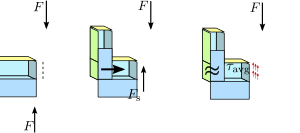Stress (mechanics) facts for kids
Stress is a measure of the internal forces inside an object. These forces happen when outside forces push or pull on the object, making it want to change its shape. Think of it as how much force is spread out over a certain area within the material.
When you pull or push on something, the tiny parts inside that object push or pull back on each other. Stress is the average force that one tiny part of the object puts on another tiny part, across an imaginary surface between them.
The basic way to calculate stress is:

Here, `σ` (pronounced "sigma") stands for stress, `F` is the force applied, and `A` is the area over which the force is spread.
In the SI system, force is measured in newtons (N), and area is measured in square metres (m²). So, stress is measured in newtons per square meter (N/m²). This unit is also called the pascal (Pa). One pascal is equal to one N/m². In other systems, like Imperial units, stress can be measured in pound-force per square inch, often shortened to "psi". Stress has the same units as pressure.
When a material is under stress, it can change shape. If the stress is too high, the material might break or change its shape permanently. Engineers study stress to make sure structures like bridges and buildings are strong enough to handle the forces they will experience.
Contents
Types of Stress
In simple situations, we can describe stress with a single number or a direction. Two main types are normal stress and shear stress.
Normal Stress
Normal stress happens when the force is pushing or pulling straight into or out of a surface. It's like pushing directly on a wall or pulling on a rope.
Tensile Stress
Tensile stress is a type of normal stress that tries to pull a material apart. When something is under tensile stress, its length tends to increase in the direction of the pull. Imagine pulling on a rubber band; it gets longer. The forces are pulling away from each other.
Things like ropes, soil anchors, and bolts are often designed to handle tensile stress. Parts of a beam that are bending can also experience tensile stress. If the tensile stress gets too high, the material can reach its tensile strength and break.
Compressive Stress
Compressive stress is the opposite of tensile stress. It happens when forces push a material together, trying to make it shorter or smaller. Think of standing on a soda can; you are putting it under compressive stress. Pillars and foundations in buildings are designed to handle compressive stress.
Shear Stress
Shear stress happens when forces act parallel to a surface, causing parts of the material to slide past each other. Imagine using scissors to cut paper; the blades create shear stress that makes the paper tear along the line. Another example is when wind pushes against the side of a building, trying to slide the top part of the building sideways compared to the bottom.
Stress in Different Shapes
Even though all real objects are three-dimensional, sometimes we can simplify how we think about them. If an object is very long and thin (like a wire) or very wide and thin (like a sheet of metal), we might model it as one-dimensional. This makes the math easier to understand how stress affects it. For example, a fishing pole can be thought of as a one-dimensional object when considering how it bends under the pull of a fish.
Related pages
Images for kids
-
A Roman-era bridge in Switzerland shows how structures handle stress.
-
A tank car is made from bent and welded steel plates, designed to handle stress.
-
A fishing pole can be thought of as a one-dimensional object for stress studies.
See also
 In Spanish: Tensión mecánica para niños
In Spanish: Tensión mecánica para niños








